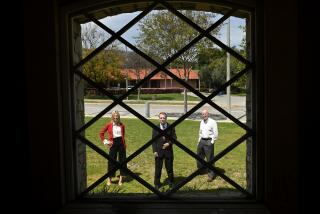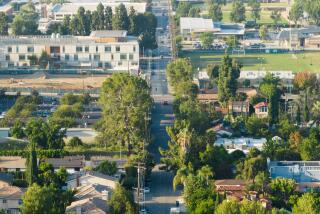Editorial: It’s time for cities to start building their fair share of housing
For 50 years, California law has required cities and counties to produce book-length reports explaining how and where they could accommodate both the affordable and market-rate housing development needed to house their share of an ever-growing state population. These reports and construction goals are supposed to be the backbone of the state’s housing strategy.
But all that paper hasn’t produced the needed homes. Why? Because the “fair share” law has become an elaborate shell game, as a recent Times story revealed. Local elected officials can claim they have complied with the law by adopting detailed plans showing where they could put new housing — even if they have no intention of allowing that housing to be built in their city. And there’s no penalty for scofflaw cities that thumb their noses at their own housing goals.
As a result, California communities have consistently failed to build enough housing to keep up with growth. The state projected it would need 1.5 million new homes between 2003 and 2014. Fewer than half that amount were built.
Just look at La Cañada Flintridge, an affluent single-family-home suburb in Los Angeles County where city leaders were required to plan for more than 300 new dwellings after falling short of previous housing goals. But recalcitrant city leaders adopted a plan that was so intentionally onerous for developers, it pretty much guaranteed that new housing wouldn’t be built. Four years later, none of the multifamily housing called for in the fair-share plan has been constructed.
Decades of insufficient construction have created a shortage that is now raising rents and home values much faster than incomes.
Far too many local elected leaders, like those in La Cañada Flintridge, have tried to block development to ward off population growth that will inevitably come as long as Californians keep having children and creating jobs. Is it any surprise, then, that California is in a housing crisis? Decades of insufficient construction have created a shortage that is now raising rents and home values much faster than incomes, a problem that is most acute in the pricey coastal regions like the San Francisco Bay Area and Southern California. One in 3 renters in California pays more than half their income to their landlord, crimping budgets for other essentials and leaving too many residents one unexpected expense away from homelessness.
Although housing construction and prices rise and fall with the economy and interest rates, cities and counties also play an important role in determining how many homes get built — or don’t get built — and whom they house. The state’s interest is in making sure enough housing is built to avert problems that extend beyond local borders. When residents cannot afford to live near jobs, they often move to far-flung suburbs and commute hours each day to get to work, worsening traffic and air pollution. Employers say high housing costs also hurt the state’s economy by making it hard to attract and retain skilled workers — a problem that has led some companies to relocate to states where their middle-class workers can buy homes.
That’s why California mandated the fair-share plans, also known as “housing elements,” in 1967. It was an attempt to make cities and counties plan to meet the housing needs of everyone in the community — rich and poor alike. Yet housing advocates have long complained that the law is toothless. That was by design, in part because cities can’t control the real estate market or force developers to build houses. But that well-intentioned flexibility has allowed many local elected officials to act on their worst NIMBY instincts and shirk their responsibility to house current and future generations of Californians.
Now, state Sen. Scott Wiener (D-San Francisco) has proposed putting some sharp teeth to the law. His bill (SB 35) would require cities that have fallen behind on their housing goals to streamline approval of certain residential projects, barring them from requiring any additional environmental review or city council vote. To qualify for fast-track approval, developers would have to comply with existing zoning and design rules, make at least 10% of their units affordable for lower-income residents, and not demolish rent-controlled apartments or existing low-income units.
Cities, of course, are loath to lose any local control over land use, and many are fighting SB 35. But the bill wouldn’t eliminate local control; it would require cities to follow their own land-use plans and speed approvals so they can finally meet their housing goals, which is what fair-share housing law was supposed to be doing all along.
There is a problem with the measure worth noting. Even as it would speed approval for housing developments in these communities, it would make these expedited projects more expensive to build by requiring the developers to pay construction workers prevailing wages, which tend to be double nonunion wages. That trade-off, which Wiener included to win support of politically powerful unions, could make it harder for smaller development projects to pencil out, potentially reducing the amount of housing being built. If so, it would defeat the very purpose of the bill.
Follow the Opinion section on Twitter @latimesopinion and Facebook
More to Read
A cure for the common opinion
Get thought-provoking perspectives with our weekly newsletter.
You may occasionally receive promotional content from the Los Angeles Times.






